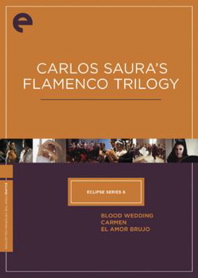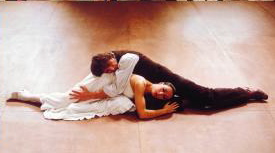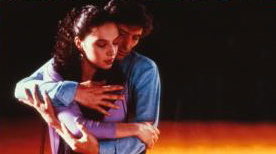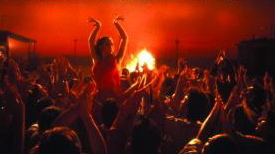| Release List | Reviews | Price Search | Shop | Newsletter | Forum | DVD Giveaways | Blu-Ray/ HD DVD | Advertise |
| Reviews & Columns |
|
Reviews DVD TV on DVD Blu-ray International DVDs Theatrical Reviews by Studio Video Games Features Collector Series DVDs Easter Egg Database Interviews DVD Talk TV DVD Talk Radio Feature Articles Columns Anime Talk DVD Savant HD Talk Horror DVDs Silent DVD
|
DVD Talk Forum |
|
|
| Resources |
|
DVD Price Search Customer Service #'s RCE Info Links |
|
Columns
|
 |
Carlos Saura's Flamenco Trilogy |

|
Carlos Saura's Flamenco Trilogy Blood Wedding (Bodas de sangre), Carmen, El Amor Brujo Eclipse Series #6 1981 -86 / Color / 1:33 flat full frame (Blood Wedding), 1:78 anamorphic widescreen (Carmen and El Amor Brujo) / Street Date October 16, 2007 / 44.95 Starring Antonio Gades, Cristina Hoyos, Laura del Sol, Juan Antonio Jiménez Cinematography Teodoro Escamilla Choreography Antonio Gades & Carlos Saura Film Editor Pedro del Rey, Pablo González del Amo Produced by Emiliano Piedra Directed by Carlos Saura & Antonio Gades |
Carlos Saura's Flamenco Trilogy is a thrilling set of movies for dance fans, fans of Spanish culture and musical fans looking for something different. Knowledgeable dance critics and online DVD reviewers don't have much of an overlap, so I wouldn't expect too many online reviews of this impressive disc set. My appreciation of flamenco is all second-hand and I have no formal background in dance. But these pictures are a great affirmation of film as an excellent recording medium for dance. Saura approaches each of them with a different, wholly appropriate mode of stylization. So I'll do my best.
The trilogy is a collaboration between Carlos Saura, Spain's most revered Franco-era director (Cría cuervos) and Antonio Gades, Spain's top flamenco dancer and ballet director. Instead of envisioning a story in which flamenco could appear, or simply recording performances, or their first film together Saura and Gades invented a new approach. Blood Wedding records a dress rehearsal of Gades' ballet version of Federico García Lorca's play.

The entire movie takes place in the dressing and makeup rooms, and the rehearsal hall. Nobody is introduced by name and no backstage dramas arise as the dancers prepare like professionals, retrieving makeup kits and costumes from locked storage. The musicians tune their instruments. Gades takes the group through some warm-ups and then has them get into full costume for the rehearsal: "I'm not stopping for anything this time."
When the 'show' starts we're aware of dancers waiting off to the sides, visible on camera instead of hidden in the wings of the stage. Saura stays wide on most dance moves and the drama of the Lorca story is communicated solely in dance terms. A groom's mother prepares him for his wedding, but the bride is secretly in love with another. The bride flees her own wedding party and the groom gives chase. The conclusion is a knife fight between her husband and her lover. The dances use the expressive gestures and motions of cabaret flamenco, choreographed for single dancers, pairs and groups. The mother's pride in her son is heartwarming, but the savage cultural edge shows when she sends him to bring back his bride -- she personally gives him his knife.
Antonio Gades is the main male flamenco dancer and plays the bride-stealer; he must be thirty pounds lighter than his opposite number but the flamenco moves 'puff him up' like a rooster. The men in flamenco ballet (if that is what this is) are very masculine; macho is a female compliment referring to a bull-like sexual power. In the basic flamenco duet the man expresses desire and sensitivity but also a hardness, a pride borne of deep Spanish roots. When Gades narrows his eyes, he personifies a cultural tradition.
Gades' opposite number is the lead dancer Cristina Hoyos, a striking woman possessed of a steely gaze that could peel paint. Enjoy her smiling and laughing at the makeup tables, because except for a few moments in the entire rehearsal, she's miserable, frightened or angry. Blood Wedding's best scenes are hers; Hoyos becomes a vision of desire when she dances. Although the foot-tapping part of flamenco is what we most remember from cabaret performances, Gades' choreography expresses pride, desire, shame and fear through broad movements and those amazing twisting hand movements, the ones that promise all manner of secret sensual pleasures. Whenever Spanish dance ie called 'earthy', it's really a polite euphemism for sex!
Blood Wedding is pared down to just what's necessary to launch the ballet; once it gets going we forget about the rehearsal-room surroundings and stay rooted to the story of desire, jealousy and death. Those gypsy clichés are a big part of all three shows in the trilogy.

1985's Carmen is the best known of the three films. Saura and Gades expand their canvas to take in a documentary-style approach, and much of the film still plays out in a (fancier) rehearsal hall. Gades' flamenco ballet director works his corps hard while searching for the perfect Carmen for his new adaptation of the Bizet opera. Handling the translation to flamenco guitar are musician stars Paco de Lucia, Regina Resnik and Mario del Monaco, although big sections of dance are performed to a standard recording of the opera in French. The show opens with a sharp rehearsal sequence in which Gades and his musicians try to find a meeting ground between the rhythms of the orchestra version and de Lucia's guitar. We get a stirring sampling of pure cante hondo singing, the hoarse-voiced wail of emotion that sounds midway between a Hebrew chant and a Moorish call to prayer: "Deja de llorar, no llores más ..."
Cristina Hoyos is told to her face that she's the best dancer, but she just isn't Antonio's vision of Carmen. Antonio finds his Carmen in a Madrid flamenco school. She's the beauty Laura del Sol, and she embodies all the qualities of the original in the French opera -- enticing but uncontrollable and dangerous. Antonio inspires Carmen to great dancing but also loses his soul to his obsession for her, and we all know how stories like that turn out. From the moment Gades meets Carmen, backstage reality and the tale of the gypsy seductress become romantically confused.
The dancing is mesmerizing because we participate in the rehearsal process. The Madrid dance instructor explains to her students that the flamenco dancer must try to slip into a trance-like form that's as much an attitude as a physical stance. 1 Antonio shouts at his dancers like a drill instructor, urging them to put force behind their movements.
Cristina and the 'upstart' Carmen start a fight in the tobacco factory (just rehearsal chairs and tables), which becomes a mass number with the female dance chorus. The thrilling scene benefits from Saura's nervous moving camera. Antonio and Carmen rehearse on their own for the seduction scene by dancing to the original opera score, which places the film's emotional highlight at the end of its second act. The third act billboards many other flamenco artists while moving to a finish we all know is coming. Those oversized folding knives should be engraved with a warning: "Not to be used by jealous Spanish males."

El amor brujo is the most elaborate of the three shows. The ballet by composer Manuel de Falla takes place on a stylized slum set lit as if in a Vicente Minnelli movie, and Saura flaunts the artificiality of the setting by panning from a stage door past flats and unused equipment before moving into his story. The small children Candela and José are promised in marriage by their fathers, but by the time they are of age another boy Carmelo (Gades) is heartbroken because he loves Candela (Hoyos) as well. Carmelo swallows his pain, even when José (Juan Antonio Jiménez, the groom in Blood Wedding) immediately takes a lover, sultry dancer Lucía (Laura del Sol otra vez). José is killed in a knife fight and bystander Carmelo is unjustly sent to prison for four years. Carmelo returns hoping to find Candela waiting for him, only to learn that she has gone mad: every night at midnight she walks to where José died and dances with his ghost. Carmelo's aged aunt advises him on how to break the curse of the unfaithful ghost.
El amor brujo is a worthy tale of love, madness and the supernatural, and Saura and Gades' heavily stylized settings work beautifully to create a fantastic tone. The ten year-old Carmelo morphs into the adult Carmelo behind the titles, with Gades maintaining the soul-sick look on his face whether contemplating his carpenter's shack or wishing Candela good luck in her marriage. The lighting on the shack encampment changes moods quickly, with slightly overexposed daylight suggesting a real exterior. But the cycloramic background changes color more frequently than the painted skies in the Japanese Kwaidan, so that Candela and José's wedding takes place under skies that change from purple to red from moment to moment. 2
Candela's joy turns to horror as she rises at midnight to put on the old bloody dress and walk hypnotically to her rendezvous with the bloody ghost. The resolution to the dilemma -- how can Carmelo woo a madwoman away from a phantom? -- comes with some witchy strategy but also through Candela learning her 'perfect' husband's true nature. The overall tone is lightened by one very lusty musical number. While hanging laundry the collected wives give a virgin bride-to-be a sound teasing over her coming wedding night, complete with fairly explicit explanations of 'little birdies' and 'warm nests'.
El amor brujo resolves the trilogy on a perfect note, creating its own uinverse of music and dance. The ending follows the old witch's wise counsel: "My son, the happiness of some always comes at the expense of others." Cristina de Hoyos gets to play a sympathetic romantic lead this time, and is nothing less than wonderful.
Carlos Saura's Flamenco Trilogy is the standard Eclipse package. Three discs are accompanied only by some un-attributed liner notes of high quality. The transfers are excellent; all three shows have seen poor videotape releases, and Carmen's old Image laser disc had a compromised flat transfer. Viewers wanting to learn more about Carlos Saura can reference the thorough career docu included on Criterion's Cría cuervos disc release.
On a scale of Excellent, Good, Fair, and Poor,
Carlos Saura's Flamenco Trilogy rates:
Movies: Excellent
Video: Excellent
Sound: Excellent
Supplements: none
Packaging: Keep case
Reviewed: October 9, 2007
Footnotes:
1. My wife was once a student in Madrid, and took a flamenco class from this very same lady instructor. When we first saw Carmen in 1985 she first thought that the Madrid dance studio looked familiar and then expressed shock to see her old teacher. As you can imagine, the moviegoing experience was a good one.
Return
2. Saura pulls a wonderful, subtle trick in El amor brujo. We watch Carmelo approach through a small window, perfectly framed. Then Candela walks a number of steps to the left, and opens the door to see Carmelo still perfectly framed, with the 'same' background. The change in perspective doesn't seem possible; it looks as if Saura constructed two slightly different background sets and had Carmelo hop from one to the other while Candela was walking from the window to the door. Or, perhaps the foreground set rolled in the opposite direction to create the same effect. If I read the shot correctly, Carlos Saura may have revived the German Expressionist trick of making multiple copies of sets to achieve different visual effects.
Return
Reviews on the Savant main site have additional credits information and are more likely to be updated and annotated with reader input and graphics.
Review Staff | About DVD Talk | Newsletter Subscribe | Join DVD Talk Forum
Copyright © MH Sub I, LLC dba Internet Brands. | Privacy Policy | Terms of Use
|
| Release List | Reviews | Price Search | Shop | SUBSCRIBE | Forum | DVD Giveaways | Blu-Ray/ HD DVD | Advertise |





